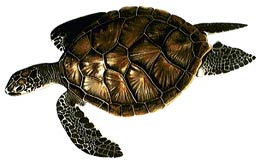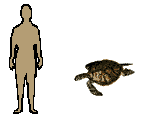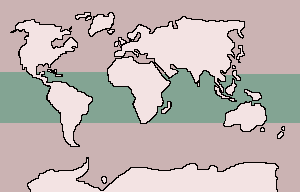Green Turtle

| Class: Reptilia:
Reptiles |
Diet: Seaweed |
| Order:
Chelonia: Turtles and Tortoises |
| Size:
1 - 1.2 m (3 1/4 - 4 ft) |
| Family: Chelonidae:
Marine Turtles |
Conservation Status:
Endangered |
| Scientific Name: Chelonia
mydas |
Habitat: coasts,
open sea |
| Range:
Worldwide in seas where temperature does not fall below 20 C. (68 F.) |
 This
large, thoroughly aquatic turtle rarely comes to land except to bask and
sleep and to lay eggs. Males have slightly longer, narrower carapaces than
females and enlarged curved claws on the front flippers for gripping the
female when mating. Green turtles are primarily herbivorous animals
and have serrated jaw surfaces, well suited to feeding on sea grasses and
seaweed; some crustaceans and jellyfish may also be eaten. This
large, thoroughly aquatic turtle rarely comes to land except to bask and
sleep and to lay eggs. Males have slightly longer, narrower carapaces than
females and enlarged curved claws on the front flippers for gripping the
female when mating. Green turtles are primarily herbivorous animals
and have serrated jaw surfaces, well suited to feeding on sea grasses and
seaweed; some crustaceans and jellyfish may also be eaten.
 The
best feeding grounds, where there are vast underwater pastures of plants,
are often far away from the best nesting beaches, and green turtles have
evolved astounding migratory habits. At nesting time they travel hundreds
of miles to the beach of their birth to lay eggs, and as a result, there
tend to be a limited number of important nesting sites, to which hundreds
of turtles go. One such site is Ascension Island in the mid-Atlantic.
Every second or third year, green turtles travel to their nesting site
and mate. The female heaves herself up the beach well away from the tidal
area. With her foreflippers she sweeps away sand to create a hollow to
lie in, her shell flush with the beach. She then uses her hind flippers
to dig a hole about 40 cm (16 in) deep, immediately beneath her tail. She
deposits her eggs into the hole, covers the area with sand and returns
to the sea. The average clutch contains about 106 eggs. Sometimes a female
lays several clutches in a season at 2-week intervals. After a 2-
to 3-month incubation period, the young turtles hatch and dig their way
through the sand to the surface. Having oriented themselves, they rush
for the sea, past a horde of eager predators. Mortality is high, and those
which do reach the sea will have to face yet more predators. The
best feeding grounds, where there are vast underwater pastures of plants,
are often far away from the best nesting beaches, and green turtles have
evolved astounding migratory habits. At nesting time they travel hundreds
of miles to the beach of their birth to lay eggs, and as a result, there
tend to be a limited number of important nesting sites, to which hundreds
of turtles go. One such site is Ascension Island in the mid-Atlantic.
Every second or third year, green turtles travel to their nesting site
and mate. The female heaves herself up the beach well away from the tidal
area. With her foreflippers she sweeps away sand to create a hollow to
lie in, her shell flush with the beach. She then uses her hind flippers
to dig a hole about 40 cm (16 in) deep, immediately beneath her tail. She
deposits her eggs into the hole, covers the area with sand and returns
to the sea. The average clutch contains about 106 eggs. Sometimes a female
lays several clutches in a season at 2-week intervals. After a 2-
to 3-month incubation period, the young turtles hatch and dig their way
through the sand to the surface. Having oriented themselves, they rush
for the sea, past a horde of eager predators. Mortality is high, and those
which do reach the sea will have to face yet more predators.
The green turtle is now an endangered species, and the
population has been eliminated in some areas, although it is still reasonable
in others. The turtles have been overexploited for their meat, hides and
eggs, and the predictability of their nesting habits has made them easy
victims. Exploitation is now strictly controlled, and imports are banned
in many countries. The closely related flatback turtle, C. depressa,
is a little smaller than the green turtle and lives off the coast of Northern
Australia.
  
|

